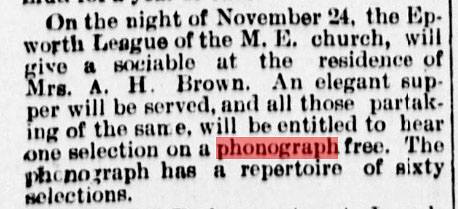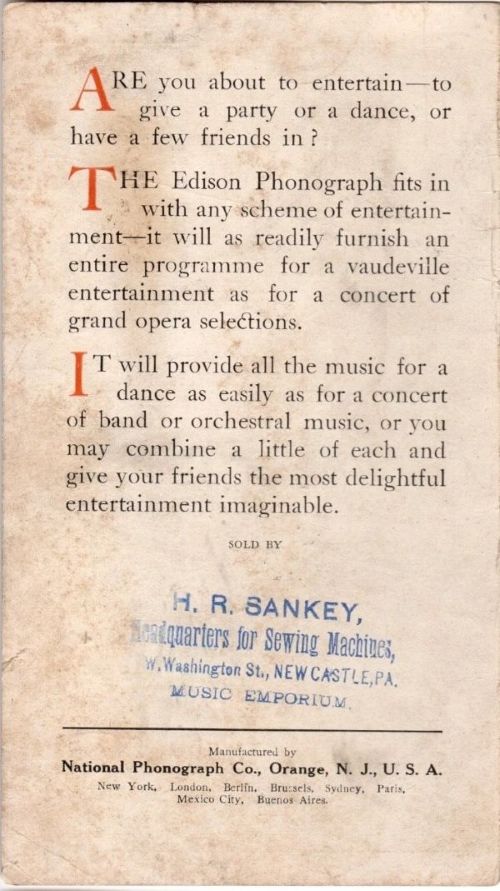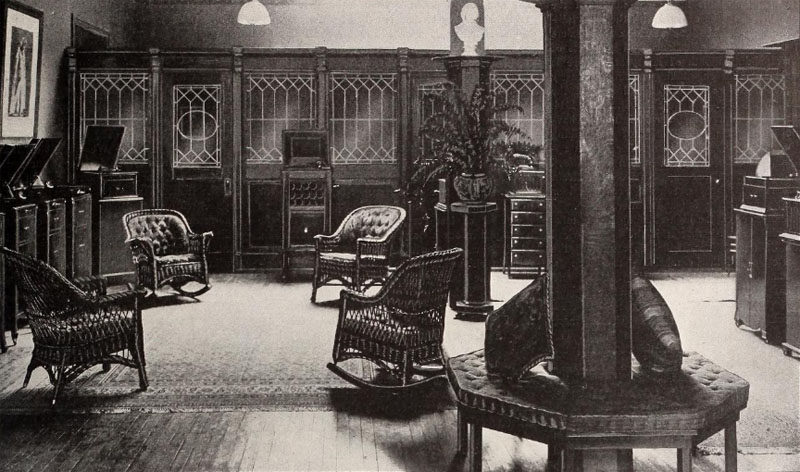By Doug Boilesen 2023
Demonstrations of the phonograph and
its recorded sounds have attracted attention, entertained, and been
used to sell phonographs and records throughout the phonograph's history.
There have been different devices, records and venues for these demonstrations
but the phonograph industry has always found ways for the public hear
it for themselves.
In the beginning Edison's tinfoil Phonograph
demonstrations featured a machine that was seen as a novelty which
could magically capture and replay sound - a voice, a trumpet, a dog
barking. It was also promoted as the new scientific wonder made by
"The Wizard of Menlo Park," sometimes referred to in newspapers
as Professor Edison."
While the early demonstrations might
have had similiarities with going to a carnival sideshow, a magic
show or a science lecture, a decade later the improved phonograph
had a new public venue with its introduction as a coin-in-the-slot
entertainer. It was a profitable business, so much so that it was
soon followed by machines and respective advertising designed to bring
the phonograph into the home and a much larger market.
To make it a popular home entertainment
device the phonograph industry had to keep improving its sound quality,
make it cheaper and offer a variety of more and more records. Regarding
the listening quality some early 20th century advertisements confidently
stated that there was now no difference between live performers and
recorded voices. The public was accordingly asked again to hear it
for themselves but now there were local phonograph dealers available
to provide those demonstrations.
Acoustic recordings would be replaced
by electric recordings in the 1920's and 1950's advertisements promoted
high-fidelity followed by stereophonic sound. Each change was accompanied
with the proposition that the quality of sound could be verified with
demonstrations and "if you hear it you'll want it."
The following is a gallery with examples
of how the phonograph has been demonstrated ever since its first public
words were heard in the offices of Scientific American on December
7, 1877. From then on the phonograph industry has said it wanted the
public to hear it for themselves. As one of the phonograph's advertising
phrases succinctly put it "Hearing
is Believing!"
Demonstrating the
Phonograph - 1878
Early tinfoil phonographs were exhibited
in meeting halls, opera houses or wherever a lecture/demonstration
could be held. For 25 cents you could hear "The Greatest Triumph
Known to Ancient or Modern Science!" (4A).
Those demonstrations could include some facts from a science and technology
perspective but most were attending for the experience of hearing
for themselves the "wonder" of a machine that records and
reproduces voices and sounds.
Curiosity and the novelty of such a
device were the early incentives to pay money for a presentation.
It's easy to think of those early tinfoil phonograph demonstrations
as sideshow attractions since the public's expectations weres defined
in a "come and hear it for yourself" style promotions. It
was a chance to see an actual recording made and hear a machine repeat
back whatever had been recorded. With the turn of a crank the Phonograph
magically performed: "It Talks! It Sings! It Laughs! It Plays
Cornet Songs."
Listeners were surely astonished at
what they heard from the simple device. There were also a few skeptics
who thought there must be a ventriloquist
or some trick taking place -- understandable reactions since the demonstration
of such a device had those elements of a magic show -- but there was
no rabbit being pulled from a hat and no ventriloquist.
The writer of the Scientific American
article describing what was witnessed at the Phonograph's first public
demonstration summarizes the experience that many must have felt:
"It is impossible to listen to the mechanical speech without his experiencing
the idea that his senses are deceiving him." Scientific
American, December 22, 1878.

The recording medium of Edison's Phonograph
was originally tinfoil so the process of recording sound could be
demonstrated but the 'recording' itself could not be removed and replayed.
Pieces of the tinfoil, however, did make nice souvenirs for the paid
patrons of these exhibitions. Those demonstrations were not promoting
a consumer product, but they were offering the experience of seeing
a recording of the human voice being made and then witnessing, with
their own ears, the replay of the recorded sound in what was essentially
a one-time listening performance.

The Laramie Daily
Sentinel, May 3, 1878
A little more than a decade after Edison
demonstrated his tinfoil phonograph to President Hayes in the White
House Edison's "Perfected" Phonographs and Columbia Graphophones
were playing wax cylinder records. Those new listening devices would
again be limited by location and number of machines available but
the phonograph's record now had a longer life-cycle which allowed
it to be played multiple times.
Nickel-in-the-Slot Phonographs -
1889
The phonograph's business case also
would improve with the introduction of the new coin-in-the-slot phonographs
which proved to be popular and profitable. Records of the early 1890's
featured band music, quartettes, vocal and cornet solos and talking
monologues which could be humorous, risque, a story, or perhaps even
an advertisement for soap followed by some free band music.
The first nickel-in-the-slot phonograph
was installed by Louis Glass inside the Palais Royale Saloon in San
Francisco on November 23, 1889. In a sense, this was the official
audition of the new and personal way to hear music and recorded stories
which were not dependent on a traveling exhibitor demonstrating the
phonograph or a live performer in a music hall.
Patrons could read the name of the
record on the machine's sign board and follow its directions; or the
proprietor or phonograph parlor attendant could provide assistance.
There was only one record per machine but it gave many people their
first experience of recorded sound and potentially the interest to
hear another story or song.

Albert K. Keller nickel-in-the-slot
phonograph, Electrical Review, August 9, 1890 (Courtesy Allen
Koenigsberg)
.
While coin-in-the slot machines were
appearing in saloons, hotels, ferry depots, and other public locations
traveling phonograph exhibitors and salesmen were also providing phonograph
concerts and demonstrations in towns of all sizes.

The Red Cloud Chief,
Red Cloud, NE, August 28, 1891
Phonograph Rooms and Phonograph Concerts
- The 1890's
In Kalamazoo, Michigan's "the
first "Phonograph Rooms” were opened in 1895 at the northwest
corner of West Main and Rose streets in the Chase Block, where locals
were given the chance to “investigate phonographs and graphophones
for family use” (The Kalamazoo Gazette). Although the business only
lasted a short time, it did help introduce the locals to the idea
of recorded music. ("Kalamazoo’s Early Music Stores,"
Kalamazoo's
Public Library, December 6, 2023). By
1915 many of the larger stores had listening
rooms, demonstration booths and even "recital halls"
to provide listening environments designed to provide the best listening
experience and encourage sales.
There are also many examples of phonograph
'concerts' in small towns across the country where the phonograph
was being exhibited at a school, or used for fund raising, or part
of a social gathering at someone's home where the phonograph might
have been purchased and been the only one in town.

Sociable at the residence
of Mrs. A. H. Brown with supper and one selection on a phonograph
free. The Red Cloud Chief, Red Cloud, NE, November 17, 1893,

"The Graphophone
Social," The Phonoscope, November 1898

Graphophone concert to
raise money for a public school flag, The Phonoscope, November
1898
Phonograph music could also be combined
with a magic lantern show, a moving picture show, illustrated song
slides, or with a local live performance at a church, school, or local
opera house.
It was cautioned by some, however, that
if phonograph dealers weren't involved in some way with these performances,
the "demonstrations" of the phonograph could result in negative
opinions about phonograph records. In 1910 one dealer commented in
The Talking Machine World exactly to that point, saying the
tendency to stop using phonograph records for the song slides at the
movies and replace them with live singers was a good thing. Why? Because
the records were being played so much they could hardly be understood
and "the result was anything but good publicity for the talking
machine."

The Talking Machine
World, September 1910
See the gallery of
Magic Lantern Shows for some re-created examples which use magic
lantern slides accompanied by cylinder phonograph records to illustrate
how the Phonograph and the magic lantern could provide multimedia
entertainment to paying audiences circa 1900.
See the gallery of Phonograph
Music for the Movies for examples of phonograph music used in
local movie houses to demonstrate the phonograph and provide music
for the 'silent movies."

The Edison concert phonograph
- "Have you heard it?" c.1899 [Cincinnati ; N.Y.: The U.S.
Printing Co] Photograph.
Retrieved from the Library of Congress.
"Half
the Pleasures in Life come through the ear. The only way
to preserve these pleasures in their perfection, and enjoy them at
will is by owning a genuine Edison Phonograph."

Munsey's Magazine,
February 1899, 2 3/4" x 4"
A phonograph concert was also a way
to normalize the phonograph, a machine, as being the performer
in a music program and an entertaining substitute for live performers.
An 1896 Berliner Gramophone Christmas ad in Munsey's Magazine featured
an attentive and smiling group in a private parlor listening to a
home entertainment "Programme." The 'playlist' was
included as part of the ad with this being one of the earliest phonograph
"playlists."

Munsey's Magazine,
December, 1896 (PM-0910)

The Outlook, November
28, 1896 (back cover) - Note: Earliest known version of this ad was
published in The Christian Work, November 19, 1896 p. 822.
(Courtesy Allen Koenigsberg). See
Phonographia's 1896 Berliner
Gramophone Christmas Programme to listen to records from this
playlist.
The 1900's
Phonograph dealers continued sponsoring
concerts and public demonstrations, often presenting them as a free
"Grand Concert" for the general public.
The following is an example from 1905
of the Thomas Book Store, which sold Edison Phonographs and Records
in Madison, Nebraska, renting the local Hein Opera House to put on
a free phonograph concert. The event was noted in the November 1905
edition of The Edison Phonograph Monthly.


A merchant in Ponca City,
Oklahoma in 1905 gave a phonograph demonstration in Koller's hardware
store to rave reviews according to the Edison Phonograph Monthly.
"Finest instrument we ever saw or heard..." "Entertainment
was better than most fifty cent shows."

The Edison Phonograph
Monthly, May 1905

Edison Pamphlet - Grand Konzert Today Admission 2 Marbles (PM-2279)

Inside Edison Pamphlet (PM-2279)

Backside of Edison Pamphlet (PM-2279)
Come hear the
phonograph for yourself.
"Hearing is Believing
-- and you can hear today at the nearest Columbia dealer's."

"It is reality, nothing less;
for "The Stage of the World" presents the artists
themselves to you..." Columbia Grafonola, 1916

"You Can Afford
the Best But You Cannot Afford to Buy a Phonograph Before Hearing
The Pathé Pathéphone." The Talking Machine
World, June 15, 1915
Edison Tone Tests
1915 - 1925
Edison conducted Tone Test ‘recitals’
from 1915 to 1925 to demonstrate his new Diamond Disc phonograph
recordings. Those demonstrations weren't simply to listen to a
record. Instead, listeners
would be asked if they could distinguish between a live performing
artist and an Edison record.

The Literary Digest
for January 24, 1920
"After you have
heard the New Edison you could scracely be contented with a talking
machine. In your locality there is a merchant licensed by Mr.
Edison to demonstrate this new instrument. You will not be importuned
to buy." - "The Test of Tests," The
Saturday Evening Post, 1917.
For more details about
the Edison Tone Tests see Phonographia's Edison
Tone Tests.

Demonstration
Records - 1950's and beyond
The demonstration of records
continued as new record formats and devices were introduced. One way
of promoting the introduction of the long-playing 33 1/3 records in
the 1950's was by creating "demonstration Records" which
were designed to impress listeners with the quality of the recording
and the improved performance of a high-fidelity phonograph.
When stereophonic sound
was added to phonograph records there were again 'demonstration records'
to showcase what the new dimension of stereo brought into the home.
Trade magazines like Stereo Review and Ohm Acoustics, a maker
of stereo speakers, and others would also create demonstration records
to support the proposition that what was being heard with each new
demonstration record was the new state-of-the-art phonograph and its
records.
In 1954 RCA Victor issued
their demonstration LP record titled "Hearing is Believing"
and asked listeners to hear for themselves what "High Fidelity"
and the "brilliant RCA Victor New Orthophonic Recording"
could produce in a before and after listening test. RCA was
also introducing their new "Gruve/Gard" with its new raised
rim and center to "give permanent protection to the record surface."

"Hearing is Believing,
RCA Victor "New Orthophonic" Recording, The Saturday
Evening Post, October 9, 1954. (PM-1522)

"Hi-Fi Demonstration
Record - a musical test of phonograph performance," Capitol
Records, 1956 - A Demonstration Record Not for Sale
"with musical excerpts specially selected to help you judge
phonograph quality" and recorded in FDS - Full Dimensional
Sound.

Roulette Presents
A Demonstration of the New Dimensional Sound of Dynamic Stereo,
Roulette Records, Inc., 1958
"This recording
has been produced to introduce and demonstrate to the listener...DYNAMIC
STEREO."

"Stereo Review's
Stereo Demonstration Record - A stunning series of demonstrations
each designed to show off one or more aspects of music sound and its
stereo reproduction." Stereo Review's compilation record,
ZD-767, 1973. Pressed by Allentown Record, Co. - Ziff-Davies Publishing
Company, New York, N.Y.

Stereo Imaging Demonstration
Record, Ohm Acoustics Corp., Ultra-Analog Processing, 1982 (FP-1342)
"Stereo Imaging
is purely, but not so simply, the ability of loudspeakers to reproduce
music three-dimensionally. Most speakers can't....The cuts we've compiled
for this album will enable you to test your speakers for all three
of the elements comprising a stereo image: placement, height and depth,
and room ambience." (Back of album's explanation by Ohm Acoustics).
Record
Listening Booths in the 20th Century
Private listening booths
and demonstration rooms were designed to enhance the customer's listening
experience when shopping for a new machine or record. As such they
were another venue for the demonstration of recorded sounds.
For examples of listening
booths in phonograph dealer's stores, record stores, department stores,
libraries and popular culture, see Phonographia's Record
Listening Booths.

Installation for Fulton
Music Company, Waterbury, Conn. - The Talking Machine World,
May 1915.

Record Listening Room,
The Saturday Evening Post, April 19, 1952
Demonstration
Rooms in the 21st Century
Box stores like Best
Buy and audio stores specializing in higher-end sound systems
continue to offer customers the opportunity to listen to records and
digital recordings in their audio rooms where different speakers and
components can be switched back and forth. The listener of these demonstrations
is still being given the opportunity to find the right system per
their ears (and now also their eyes for the multimedia systems) and
their budget.
Demonstrations of sound
started with the tinfoil phonograph demonstrations and ever since
there have been "hearing is believing"; experiences. The
major difference, however, is that for most it's no longer a wonder
to experience ephemeral sound captured and heard. Instead, the
demonstrations in stores is connected with whether or not what you
hear is worth purchasing, i.e., is it significantly better than how
you already experience sound; is there some new benefit to how you
can hear music if you purchase a new music delivering device; or does
streaming of music and the wireless headphones/earbuds make those
decisions even simpler?
The technologies and quality
of sound and variety of music available have exponentially changed.
Physical media and phonograph records are niche formats. The shift
to more personal listening also is a factor. Fundamentally, however,
whether it's a family listening to music as part of a home entertainment
system or a single listener streaming music from their iPhone, the
"Stage
of the World" and "Best Seat in the House" advertising
messages have not changed: You, as the listener, are still being offered
the best seat in the house.
For myself, however, having
the best seat in the house for listening to the recorded music of
world, anytime, anywhere
and as often as I want will always be associated with the wonder and
magic of the phonograph and recorded sound.
Perhaps that's because
I'm a Friend of the Phonograph.
But I think it's more than
that, and would suggest that the Scientific American writer's
reaction at the phonograph's first public demonstration is a reminder
of that wonder and magic when he wrote "it is impossible to listen
to the mechanical speech without his experiencing the idea that his
senses are deceiving him."
It was a wonder in 1877.
It's still a wonder today.